When your hobby also happens to be your livelihood – which is the case for embroidery and me – it’s sometimes necessary to pursue a different hobby now and then!
I have a couple hobbies that are not needle-and-thread-related pursuits, but I don’t often indulge in them anymore simply because there’s not a lot of time outside Needle ‘n Thread for other creative activities.
But over the recent Easter break, I took some time to focus on setting up a non-embroidery related project (who knows – since it involves cloth, it may morph into an embroidery-related project!) that is still needle-and-thread related, and since some of you wrote in and asked about it, I thought I’d show it to you.
There are a couple tools and accessories involved that you might like, too, so I’ll share those with you as well.
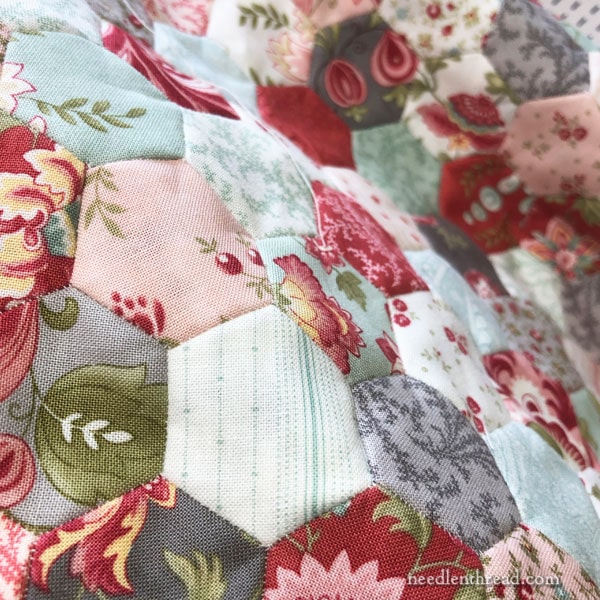
The project is a hand-pieced quilt – specifically, a hexagon quilt using English paper piecing.
I made a hand-pieced quilt once before, years and years ago when I was finishing college and starting to teach. It was a pineapple design, 49 pieces in each 8″ square, made from random scrap fabric and occasional purchased bits. There was no real color coordination in it – it really was random! – except for manipulating the placement of light and dark fabrics.
For quite a while now, I’ve wanted to make another hand-pieced, random quilt, using English paper piecing and hexagons.
You see, I like hand piecing. It’s such a portable way to have something to work on. And I’m often in situations when my hands need to be doing something, but I don’t have an embroidery project to tote around.
I also like the whole basting process of English paper piecing. It’s mindless and relaxing.
And I like working with little things. The hexies are small, at 3/4″ along each side.
In short, I like the process, the portability, and the fabric – which is why I finally took the plunge.
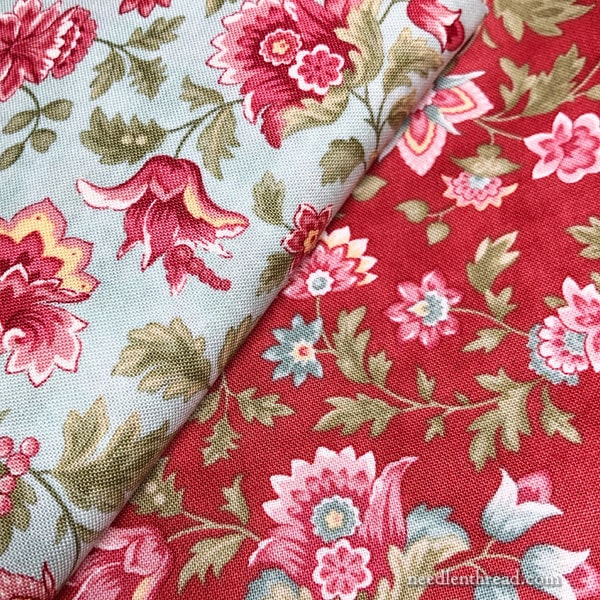
Speaking of the fabric, earlier this year, I was looking for Jacobean-inspired fabric designs, when I came across a fabric line that I really liked, called Porcelain from 3 Sisters, produced by Moda.
The colors and the designs were appealing to me, and the designs were small enough and varied enough that I thought they’d work well for little hexies. So I started collecting the fabric, though I wasn’t really ready to start the project.
It’s a funny thing about cotton quilting fabrics: If you like a fabric and you plan to do something with it, you better get it (and enough of it for your project) while you can, because next year, it won’t be around. This, I think, is what prompts quilters to “stash.”
So I did what I normally wouldn’t do, and I purchased all the fabric I would need for a quilt made from this particular fabric line, and I “stashed” it. My plan was to start this quilt some time this spring, so I figured it wouldn’t be stashed for long.
Incidentally, I don’t have a fabric stash. I have some cuts of linen that I use regularly for embroidery, but I don’t have a build up of different kinds of fabric. I don’t have space for that, and I’m not really a quilter and I don’t sew much, so I’ve never had a reason to stash fabric.
Still, warning bells went off in my head! You Cannot Become a Fabric Collector! they cried. And they are right – I can’t. So to put those bells to rest and to make myself feel better about the fabric purchase, I set aside time over my break to focus on getting this project underway.
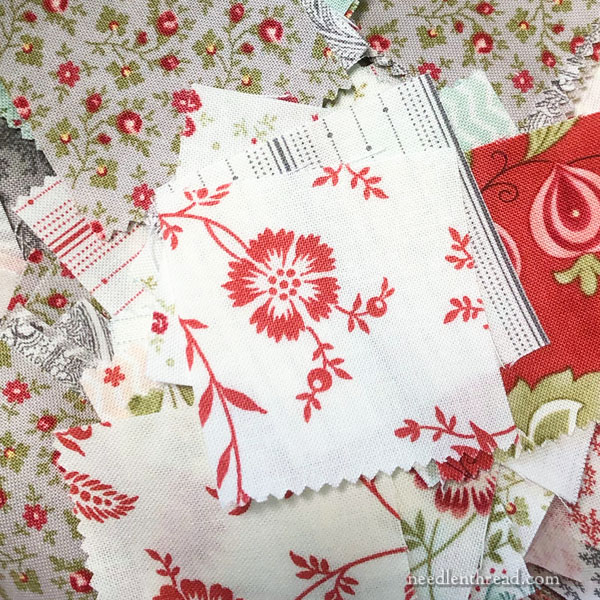
I sliced up the fabric into squares. To make it easy and more affordable, I bought the fabric in “layer cakes,” which gave me a little bit of the whole range. One piece of fabric in a layer cake (which is made up of 42 10″ squares) produces 25 2″ squares, perfect for 3/4″ hexies.
Because I’m doing English paper piecing, I don’t have to cut the fabric into hexagon shapes. Instead, I baste the squares around a paper cut out of a 3/4″ hexie, and once the hexies are sewn together, I pop the paper out.
So I sliced up a bunch of 10″ squares into 2″ squares. The quilt requires, in fact, 5,174 hexagons. Ummmmmm… no comment… I cut about half the amount I need, because I got sick of cutting. Even with a good ruler and rotary cutter, this kind of cutting is not my favorite activity in the world!
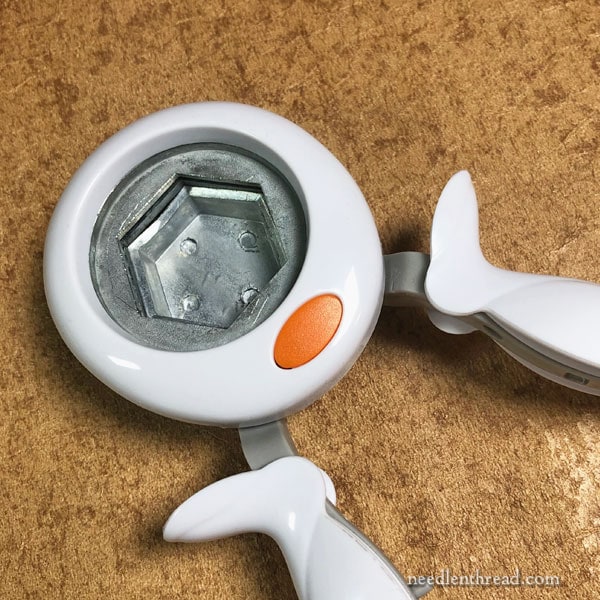
For the paper piecing part of things, I could have ordered a bunch of pre-cut hexagon papers, but I knew over time, I would need a lot of them! So instead, I bought a relatively inexpensive Fiskars hexagon paper punch, and I’m punching my own papers as I need them, using light card stock and scrap paper.
At first, I organized a small tin with some stacks of fabric, some paper hexagons, needle, thread, and scissors in it, but the open tin concept didn’t keep things organized enough for me.
It just so happens that DMC recently released a small fabric sewing box, and it just so happens that I bought one because I really wanted to see it up close and examine it’s features.
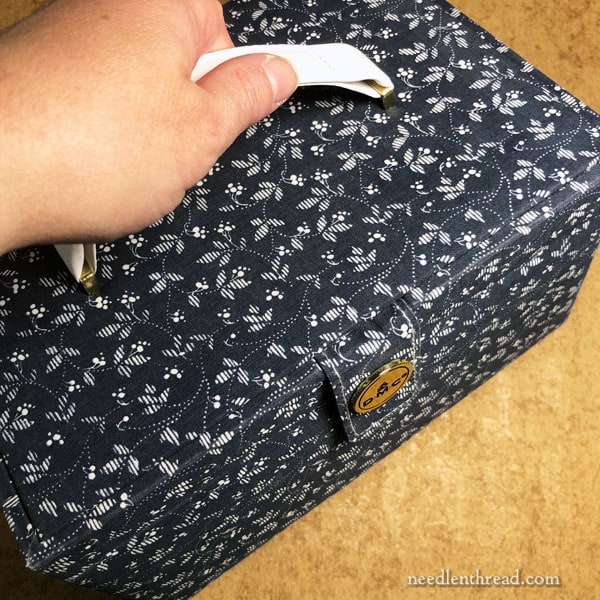
It’s definitely not your typical fabric sewing box, like the type you’d find at fabric stores here in the States. It runs more along the French “cartonnage” box making style, and it’s nice. I like it a lot!
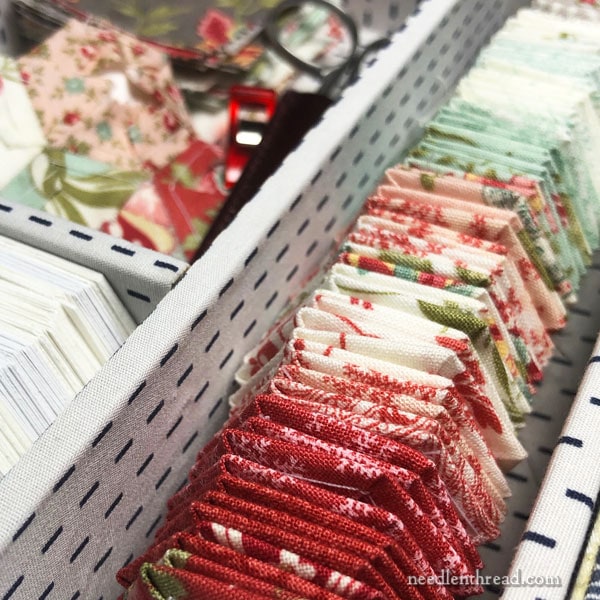
And, wonder of wonders, the 3/4″ hexies fit in it like it was made for them. Joy, bliss! I ditched the tin for the box.
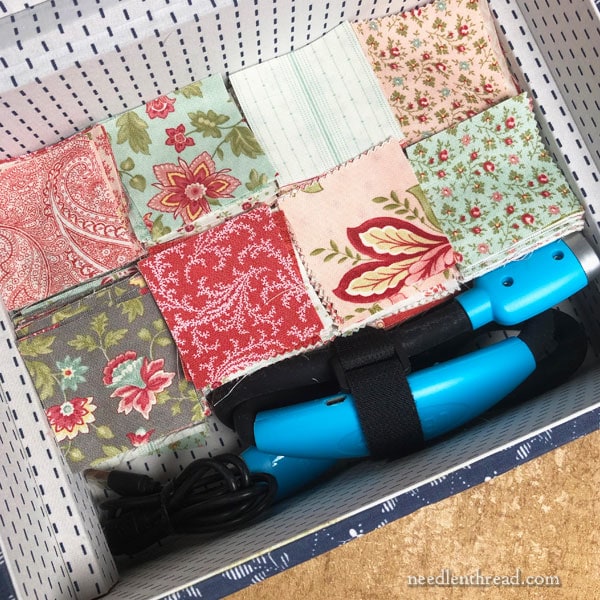
In the base of the box, I stacked in a bunch of the 2″ fabric squares and threw in my twisty neck light and charger. I will tell you about that below.
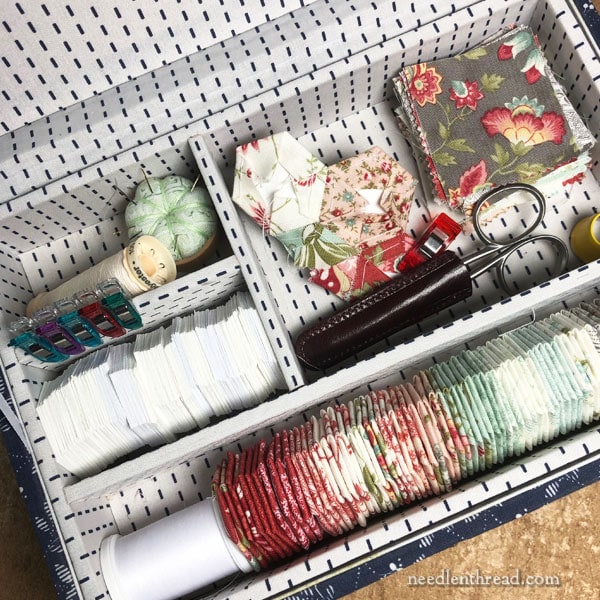
In the top tray, I have a section with paper hexagons, a section where I put basted hexagons, two spools of thread (one for basting, one for piecing) and the tools I use, which are minimal: a pair of scissors, a tiny pincushion, a thimble, and some miniature Clover clips.
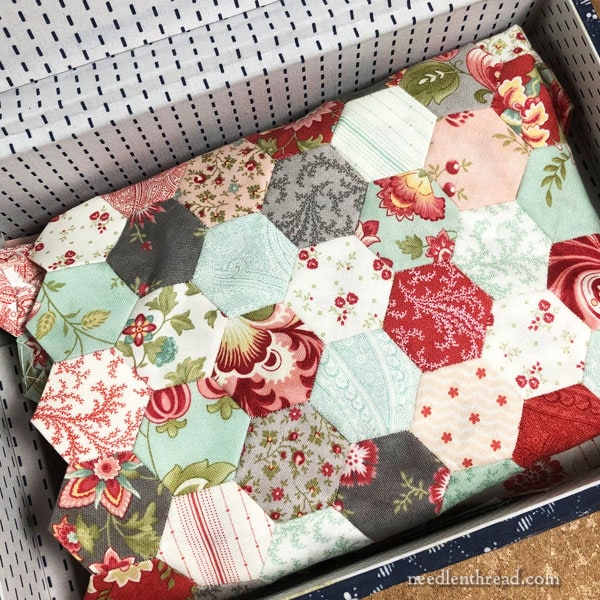
And now I have a completely transportable little box for my English paper pieced hexagon quilt that will probably take me ten forevers to complete. But hey! I won’t lack for something transportable to do with my hands!
The Neck Light
Concerning the neck light: this was recommended to me by another stitcher as an easily transportable light for sewing in dim places.
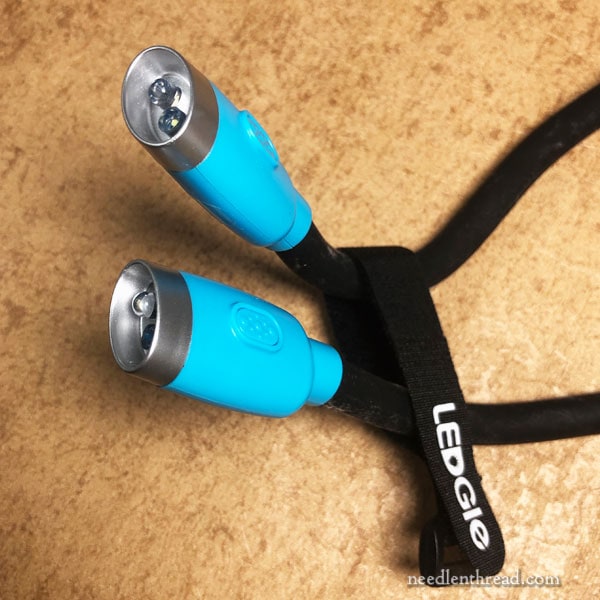
It has flexible rubber-ish rope sides that end in two little light heads, and the two sides (after being placed on your neck) can be held together with the Velcro strap. The “ropes” can be manipulated, so that you can direct the lights where you want them.
The whole apparatus is rechargeable, and it comes with a micro-USB cable. Overall, it struck me as good concept, so I got one to try, thinking I could review it for you if it proved to be useful. After all, it might work well for portable workshop or seminar lighting and so forth.
Like I said, it’s a great concept! And I wish I could recommend it without reservations! It’s comfortable enough, it’s easy to manipulate, it gives off decent, directed light to use in dimly lit situations. It’s rechargeable and it’s affordable (you can buy two of them for around $30, so you can switch off while one charges) and the battery lasts a good four to five hours on high.
However, the second time I used it, one half of the thing wouldn’t turn on. I’m going to send it back and get a replacement. In the meantime, I wrote a poor review on Amazon. After all, even if you’re purchasing something for only $16, you expect all of it to work for longer than 24 hours!
So I recommend it with reservations. Maybe I just got a dud. I’ll update you on it, when I get this one sorted and test a replacement for long enough to judge it better.
Not a Quilter!
Well, I’m not a quilter, when it comes to making quilts regularly or frequently. But I like hand piecing little bits of fabric into a quilt and hand quilting. (Does this make me a quilter?)
Still, I won’t be writing about quilting here on Needle ‘n Thread. There are a gazillion quilting websites out there that can teach you and inspire you a lot better than I ever could on that subject!
But as far as embroidery goes, I should admit that a little part of me wants to pick out elements in the fabric design and embellish them with a touch of embroidery, just for the fun of it – and so that my “ten forevers” project can turn into an infinity project. That might be a little nuts.
If I ever do it, though, I’ll let you know!
Where to Find Stuff
I have no idea where to find the Porcelain fabric line these days. I originally bought my “layer cakes” through Missouri Star Quilt Company. I had to buy the yardage for the backing somewhere else, because they were already out of yardage for most of the line by the time I discovered the fabric. If you like the fabric and want to find it, your best bet is probably Google – “Porcelain from 3 Sisters by Moda” is what you’d look for.
You can find the little sewing box (and a much larger version) on the DMC website here. The box is super sturdy, and it seems quite well made to me. I like it a lot! It’s on sale for $28 now.
You can find the Fiskars 3/4″ punch (the “large” punch) and the light both listed on my Amazon recommendations page here. I’ll leave the light there, in case it’s something you’d be interested in trying. Again, my recommendation comes with some reservations at this point, but I’ll update you once I get my light sorted.
Back to It!
I’m back to embroidery these days – and lots of website work. Some changes coming up for Needle ‘n Thread! I’ll talk about them soon!
I hope you’re making progress with your needle and thread projects!
This article includes an affiliate link to my Amazon Recommendations page, which means Needle ‘n Thread receives a small commission for orders placed through that link, at no additional expense to you. Every little bit counts! Thanks!